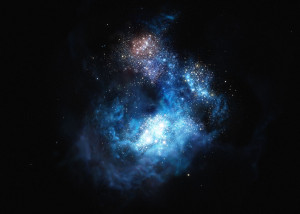Science Seen Physicist and Time One author Colin Gillespie helps you understand your world.
First Stars
Here’s more news from big telescopes. The galaxy depicted in the illustration is called CR7. It has a football flavor: Google tells me CR7 is Cristiano Ronaldo, star player for famed Spanish soccer team, Real Madrid. The galaxy named after him shows up way down on page three of my search results! That bright patch below
center is the breakthrough in the news. It’s our first look at the first stars. A European Southern Observatory team used several telescopes to find them. This is a big deal. Here’s why.
Theory says the early universe—in its first hours and even its first million years—contained a hot gas of three elements: hydrogen, some helium and a trace of lithium. All other elements (astronomers call them metals), were made in stars. Then gravity formed stars from gas clouds; this took hundreds of millions of years. Strangely, we have strong confirmation for the earlier part of this theory but not the later. We see the hydrogen and helium and lithium in their predicted proportions. But we can’t seem to spot any of those first stars. How do they hide?
Hot atoms give off light in precise colors that are signatures of the emitting elements. So the first stars gave off “hydrogen light” and “helium light”. For example, the strongest light from hydrogen is called the Lyman-α line and it is ultraviolet. Problem: an early universe of hydrogen is perfect to absorb this light. Long before it gets to us it’s gone. Solution: over time this light ionizes the hydrogen into protons and electrons, until there are few neutral atoms to absorb more light. Thus, over hundreds of millions of years, the universe becomes transparent to the Lyman-α line.
Calculations show that the first stars were huge, a hundred or a thousand times more massive than our Sun. The next problem is a consequence of this. Their strong gravity makes these stars very hot and so they burn their hydrogen fuel fast, in millions rather than billions of years. Then they collapse in supernovas that blast their metals into space. We see lots of stars that are polluted with these metals. They form differently from the first stars thanks to the metals in them.
So here’s the challenge: Find stars that formed from unpolluted hydrogen and helium after other stars made space transparent and find them before they burn out and explode. It means looking across almost thirteen-billion light years of space through a few-million-years-wide window to a time eight-hundred-million years after the universe began. It’s like searching for a needle that was in a field of haystacks for maybe a day five years ago. The ESO team of astronomers used several big telescopes to select the CR7galaxy and to gather and decipher data from it. That bright patch has light from hydrogen and helium alone, the long-sought signature of the first stars. It is the brightest Lyman-α source ever found at such a distance. Other regions of the same galaxy have stars with metals in them, older stars that, the authors reason, ionized the local hydrogen so that the first stars’ “hydrogen light” could get away. They say:
“We may be witnessing, for the first time, direct evidence for waves of [first] star formation ….”
Recently I noted that the James Webb Space Telescope, due for launch in 2018, is suited to a search for the first stars. This ESO team jumped the gun. Congratulations! As they point out, JWST should easily be able to confirm their findings. Or it might point to an alternative: hydrogen collapsing directly to form a big black hole, a never-yet-seen entity proposed to explain how supermassive black holes formed so fast. It’s another window into how the universe began. Stay tuned.
Sources:
David Sobral et al. (2015), “Evidence for POPIII-like Stellar Populations in the Most Luminous Lyman-α Emitters at the Epoch of Re-ionisation: Spectroscopic Confirmation”, Astrophys. J., in press; Cornell University Library, http://arxiv.org/abs/1504.01734
Image credit: M. Kornmesser, European Southern Observatory, http://www.eso.org/public/images/eso1524a/


No comments yet.